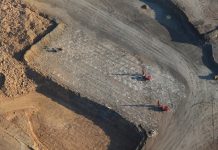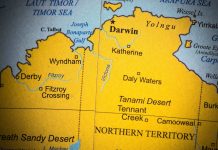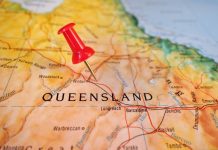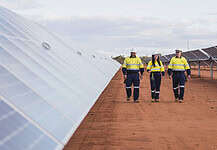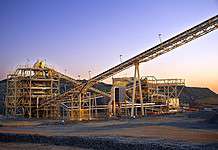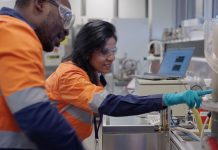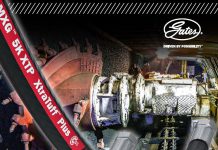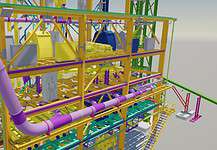The 20-metre deep box cut being constructed at Carrapateena.
By Elizabeth Fabri
MOMENTUM is building across the OZ Minerals portfolio as works advance on the second decline at Prominent Hill, and construction begins at the highly anticipated Carrapateena project.
In September, OZ Minerals began works on the Carrapateena decline, pushing the miner another step closer to delivering first concentrate in late 2019.
On 30 September a host of industry officials, including South Australian Premier Jay Weatherill, visited the site to celebrate the discovery of one of the country’s largest undeveloped copper deposits.
“Carrapateena has compelling project economics and by starting the decline now, we are further de-risking the project and creating more shareholder value,” OZ Minerals managing director and chief executive Andrew Cole said.
“Building the decline now creates approximately $90 million in net present value.”
Further north, the company’s existing mine Prominent Hill was also undergoing a transformation, with the construction of a $12 million second underground mine.
Works on the Prominent Hill decline were progressing, while steady production has given the miner confidence it will meet its 2016 guidance of between 115,000 tonnes and 125,000t of copper, and between 125,000 ounces and 135,000oz of gold.
In the first half, the mine returned 58,368t of copper and 57,662oz of gold, despite facing an operational issue with a crack in the SAG mill girth gear.
“The processing plant had a few challenges earlier in the year with some failures in different components, but I am pleased to say that plant is now running back up at name plate capacity; so all in all the operation at Prominent Hill is going very well on guidance now for the year,” Mr Cole said.
Prominent Hill expansion
Prominent Hill is proving itself to be a highly valued asset with an updated mine life now extending out to 2026.
The northern South Australian operation first came online in 2009, and now produces more than 100,000t of copper a year.
In 2012, the first underground mine Ankata was established, and in 2015 OZ Minerals commissioned the second decline Malu underground as mining at the open pit approached completion in 2018.
“By building a second decline, we will not only boost the underground’s capacity, we will significantly increase the efficiency of the whole operation and drive down future unit costs,” Mr Cole said.
“Prominent Hill has amongst the lowest C1 costs in world and, even on its own, the underground mine is within the bottom quartile of C1 cost producers.”
“Once the second decline is complete in the next two years, truck efficiencies in the underground will increase and we will see other major benefits in terms of ventilation and contingency planning.”
Mr Cole said he was pleased with how works were progressing, and the project was on schedule to be complete by the fourth quarter in 2017.
About 1200m of development was required for the decline; at the start of June the miner had completed 278m.
“My objective is to get Prominent Hill up to a sustainable 4mtpa underground operation so we can continue to convert resources to reserves and have a mine life that goes well beyond 10 years,” he said.
Hedging gold
In April OZ Minerals’ stated it would hedge a percentage of recoverable gold from its Prominent Hill stockpile to capitalise on the commodity’s strong performance as market value tipped to 15-year highs.
At the end of March, the stockpile contained 370,000oz of gold. The miner hedged about 171,200oz, which was expected to generate $293m of revenue from 2018 to 2021.
“One of the unique features of Prominent Hill is that we have a very large inventory, so it’s already been mined and its sitting on the ground effectively,” Mr Cole said.
“The gold contained in the stockpile is a tremendously valuable, de-risked asset and we have decided to lock-in approximately 60 percent of the value by taking advantage of the current historically high gold prices.”
Mr Cole said the stockpile would continue to grow over the remaining life of the open pit, and the hedge position would be reviewed on a quarterly basis.
In June, the company forecast the stockpile to contain between 450,000oz and 500,000oz of gold by 31 December 2017.
“One of the purposes of hedging some of that gold out of that stockpile is to protect our cost position. We have already mined it, so hedging a small portion of that inventory will effectively guarantee that we can treat that irrespective of what the gold price does going forward into the future,” he said.
Carrapateena development
OZ Minerals purchased the Carrapateena exploration project in 2011. Since then, pre-feasibility and scoping studies have confirmed the projectas one of Australia’s largest undeveloped copper deposits.
The high-grade iron-oxide copper-gold resource lies on the eastern margin of the Gawler Craton, about 130km north of Port Augusta, and is estimated to contain 61mt at 2.9 per cent of copper equivalent.
OZ Minerals released a pre-feasibility study in 2014, and in April 2015 the company committed to evaluating development options for the site, including a potential Gawler Craton plan to link Carrapateena to Prominent Hill via a 250 kilometre railway, and a value optimised stand-alone block cave project.
In May, the company released the results of pre feasibility study (PFS) scope optimisation work. Th results identified an increased project scope to 4mtpa, and estimated project costs of $975 million, including a $150m processing plant at Whyalla.
The new plan also predicted production for the first three full years would come in at 67,000t of copper and 76,000oz of gold each year, compared to the 55,000t of copper and 58,000oz of gold estimated in February.
The good news continued in July when mining contractor PYBAR was awarded a $65 million contract to construct the 600m deep, 7500m long decline.
“PYBAR has an excellent reputation in the underground mining industry in terms of safety, quality and execution and they will be a great partner as we build the Carrapateena project,” Mr Cole said.
PYBAR began works on the 20m box cut in July, and commenced work on the decline in September.
“The rest of the project studies are at an advanced PFS level and we expect to be able to go back to the market in a couple of months with the results of the PFS,” Mr Cole said.
“The second round drilling project at Carrapateena has finished and we’re now collecting the data and analysing the metallurgical test work from that; as soon as we have got that back we will release the results and the impact that has on the resource model.
“From everything I have seen to date the project is on track and looking as robust and as resilient as we last published. I’m pretty pleased about the work the team has done and I’m pretty excited about the future of the Carapateena project.”
Driving down costs
In the last 12 months OZ Minerals has achieved annualised procurement cost savings of $25 million, with a further $20 million identified in the pipeline.
“The cost saving programs are not primarily about saving money; they are trying to right-size our business and the cost profile for what this business should be,” Mr Cole said.
“In that process we’ve saved tens of millions of dollars over the last year and a half, and brought the operation down to a lowest quartile cost producer.
“That’s come from simplifying the business; renegotiating contracts with suppliers, focusing on the productivity levers, and focusing on the core things and making sure we do them exceptionally well.
All of those things have resulted in us bringing our overhead costs down, our operating costs down, and our project costs down.”
In addition, in March OZ Minerals demobilised equipment and personnel in the open pit at Prominent Hill, including removing one excavator and 14 trucks from the operation, and brought forward its open pit mine plan, which will save a further $60 million over the life of the open pit.
Outlook
Mr Cole said he expected 2016 to be another strong year as high grade copper production from the underground increased.
“Prominent Hill operations are producing strong cash flows today and are positioning us well to produce strong cash flows for several years to come as we unwind the building ore stockpiles after open pit closure in 2018,” he said.
“Our overarching strategy for South Australia is to create a Gawler Craton network with a hub on a coastal port.
“So the work we’re doing now means that Prominent Hill will operate for more than 10 years, Carrapateena will operate for more than 20 years, and [will lead to the development of ] a distribution and treatment plant on the coast.”
He said once this was in place, the company could continue exploring South Australia to exploit other resources; some of which are already in its portfolio, such as Fremantle Doctor and Khamsin.
OZ Minerals also recently earned into the West Musgrave Project in WA.
In August, the company signed an agreement with Cassini Resources to earn up to 70 per cent of the project dubbed Australia’s largest undeveloped copper nickel deposit.
“This deal is strategic because it gives us access to an exciting project and, importantly, a very significant proportion of a new mining province,” Mr Cole said.
“Cassini has done some great work already and I am confident that the OZ Minerals team can help forge a pathway towards commercialisation.
“Our recent work at Carrapateena clearly demonstrates that a fresh set of eyes can unlock a huge amount of value.”

